For additional information relating to this article, please contact:
December 02, 2016LABOUR MARKET TRENDS - NOVEMBER 2016 TRENDS November 2016
Nova Scotia's seasonally adjusted employment increased by 3,700 to 448,000 in November 2016. This is the largest monthly gain in employment since start of the year.
Compared to October, the labour force increased by 5,900 to 487,000 in November. With labour supply increasing at a faster pace than employment, the net result was a 0.4 percentage point increase in the seasonally adjusted unemployment rate to 8.0 per cent in November. With an increase in the labour supply outpacing growth in the working age population (+100) the participation rate climbed to 61.7 per cent for the month. With more jobs November's employment rate increased to 56.7 per cent.
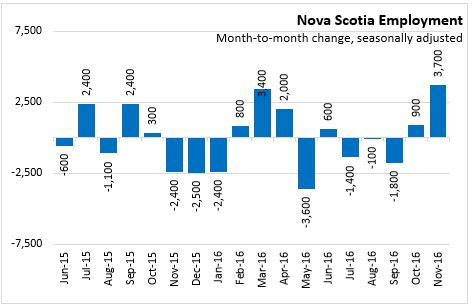
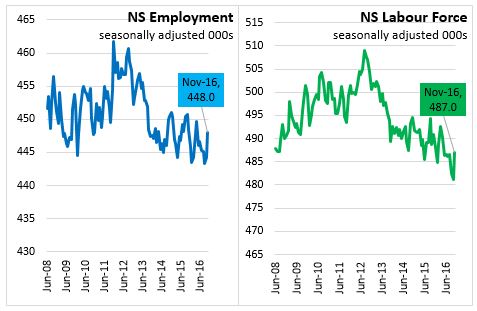

In November, the overall increase in employment reflects gain of part-time employment (3,800) over riding the losses in full-time employment (-200). Shifts in the number of hours worked can result in swings between full-time and part-time jobs.
Compared with November 2015, the labour force has decreased by 3,800 (-0.8 per cent) while employment decreased by 400 (-0.1 per cent). Full-time employment levels in November are down 13,300 from the same month last year, offsetting an increase in part-time employment of 12,800. Overall, with labour force decreasing at a faster pace than employment, the result was a 0.6 percentage point decrease in the seasonally adjusted unemployment rate from 8.6 per cent in November 2015 to 8.0 per cent in November 2016.
Year-to-Date (Jan-Nov. 2016 vs Jan-Nov. 2015)
For the first eleven months of 2016 compared to the first eleven months of 2015, there was a decrease of 2,300 (-0.5 per cent) in the average employment level. Average full time employment was down 3,300 and there were 1,000 more part-time jobs. The labour force was down 3,500 (-0.7 per cent) over this period. With labour supply falling at a faster pace compared with labour demand, the net result was a decline in the unemployment rate of 0.2 percentage points between the two periods. The average unemployment rate for the first eleven months of 2016 was 8.4 per cent. The labour force participation rate dropped 0.7 percentage points to an average of 61.7 per cent in the first eleven months of 2016. The employment rate also fell by 0.6 percentage points to 56.5 per cent.
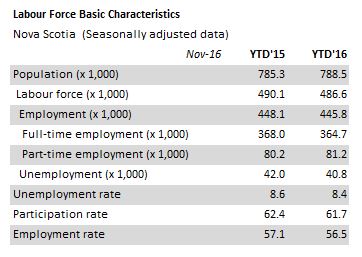
AGE COHORTS (Jan-Nov 2016 vs. Jan-Nov 2015)
The labour force survey population estimate of 15-24 year olds declined by 1,700 between Jan-Nov 2015 and Jan-Nov 2016. The age group saw a decline of 3,200 in the labour force and 2,500 in employment during this period as the number of unemployed declined. The unemployment rate decreased 0.3 percentage points to 14.9 per cent for the Jan-Nov 2016 period.
Among Nova Scotians aged 25 to 54, the labour force declined 6,300 while employment declined 6,100 between the Jan-Nov 2015 and Jan-Nov 2016 period. With both labour supply and demand declining at a similar pace,the net result was no change in the unemployment at 7.2 per cent . The labour force participation rate fell 1.1 percentage points to 85.3 per cent for this age group.
For those Nova Scotians aged 55 and over, the population, labour force and employment have all increased over the first eleven months of 2016 compared to the same period in 2015. Employment increased by 6,200, faster than the rise in the labour force of 5,900, resulting in a decline in unemployment of 300 and a fall in the unemployment rate of 0.7 percentage points to 7.4 per cent.
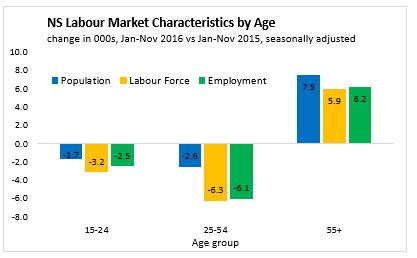
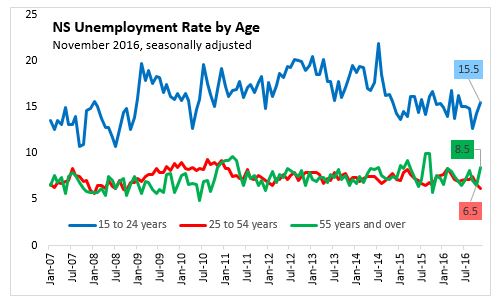
SECTORS (Jan-Nov 2016 vs. Jan-Nov 2015)
Comparing the first eleven months of 2016 to the first eleven months of 2015, employment in goods-producing sectors decreased by 1,700 jobs. Employment declines in agriculture, forestry/fishing, utilities and construction more than offset a gain of 700 net jobs in the manufacturing sector.
There was a net loss of 700 jobs in service-producing sectors. Employment gains in, financial services, health, education, public administration and other services were not enough to override the job losses in wholesale/retail trade, professional services, business/support services (includes call centres), information/culture and accommodation/food services. There was no change in employment levels in the transportation and warehousing sector.
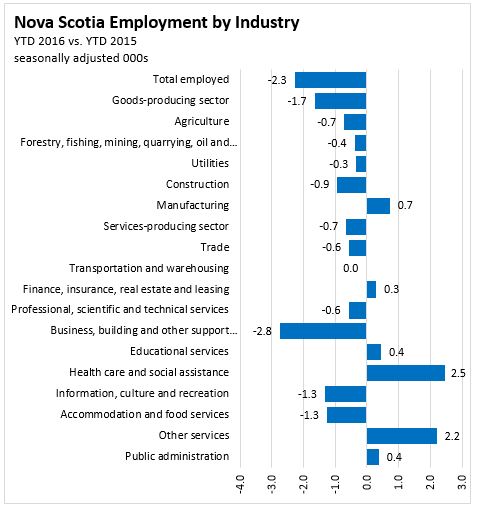
Regions (YTD 3 month moving average, unadjusted)
For the period of Jan-Nov 2016 compared to Jan-Nov 2015, the Halifax and Annapolis Valley regions employment growth outpaced labour force growth resulting in a lower average unemployment rates. In the Cape Breton and the Southern regions unemployment rates rose as employment (labour demand) declined at a faster pace than labour supply. In the Northern region, the labour force decline was larger than the decline in employment resulting in a lower rate of unemployment.
The Cape Breton region reported a decrease in employment of 2,900 (-5.6 per cent) for the first eleven months of 2016 over the first eleven months of 2015. The labour force dropped by 3,200 (-5.4 per cent) for the same period. With labour demand decreasing at a faster pace than labour supply, the result was a 0.3 percentage point increase in the unemployment rate to 15.1 per cent.
For the North Shore region, employment decreased 1,500 (-2.2 per cent) for the first eleven months of 2016 over the first eleven months of 2015. Labour supply decreased by 2,000 (-2.6 per cent) for the same period. The larger decrease in labour supply resulted in a 0.5 percentage point decline in the unemployment rate to 9.2 per cent.
The Annapolis region experienced an increase in employment of 1,700 (3.2 per cent) and an increase in the labour force of 1,600 (2.7 per cent) for the first eleven months of 2016 over the same period in 2015. The net result was a decline of 0.4 percentage points in the average unemployment rate to 8.1 per cent.
The Southern region saw employment fall by 1,500 (-3.1 per cent) and the labour force had the same decline of 1,500 jobs (-2.7 per cent) for the eleven months of 2016 over the eleven months of 2015. With the labour supply falling at a slightly slower pace than the decline in labour demand, the unemployment rate increased 0.3 percentage points to 11.2 per cent.
For the first eleven months of 2016 compared to the first eleven months of 2015, Halifax (HRM) experienced an increase in employment of 1,500 (0.7 per cent) along with an increase of 1,200 (0.5 per cent) in the labour supply. With labour market demand increasing at a slightly faster pace than labour supply, the net impact was 0.1 percentage point decrease in the unemployment rate to 6.2 per cent.
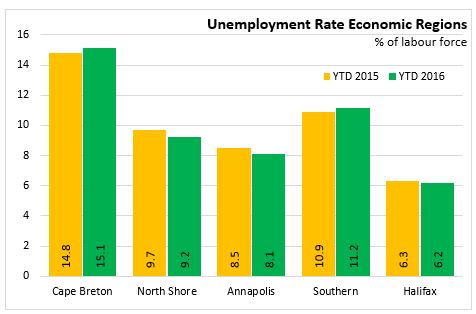
Provincial Comparisons
Employment has increased 0.7 per cent in Canada comparing the first eleven months of 2016 with the eleven months of 2015. Over this period growth has only occurred in the three largest provinces: British Columbia (+3.0%), Ontario (+1.1%) and Quebec (+0.8%). The largest declines have been in Prince Edward Island (-2.4%), Alberta (-1.6%), and Newfoundland and Labrador (-1.2%).
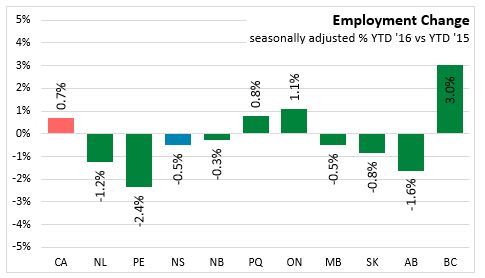
The Nova Scotia unemployment rate was 8.0 per cent in November 2016. In November of last year, the Nova Scotia unemployment rate was 8.6 per cent. Four provinces have lower unemployment rates compared to last year including Nova Scotia, Quebec, Ontario and British Columbia. The lowest unemployment rate among the provinces in October 2016 was in British Columbia at 6.1 per cent.
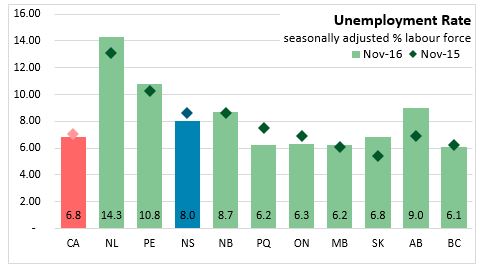
National Comparisons: Cities
The seasonally adjusted unemployment rate for the Halifax Census Metropolitan Area was 5.9% per cent. Guelph (4.2%) had the lowest unemployment rate in Canada this month.
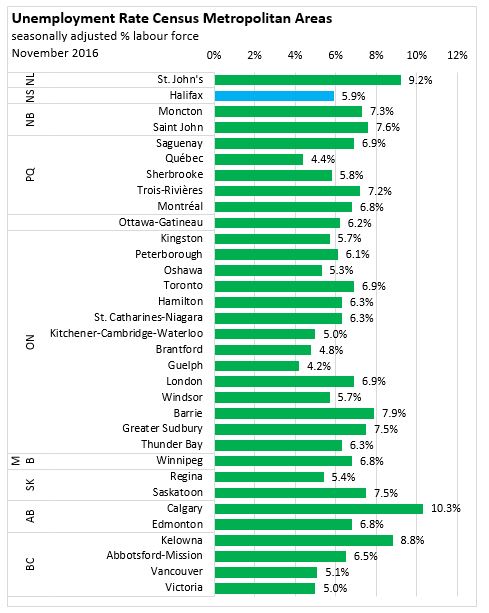
The seasonally adjusted employment rate for the Halifax Census Metropolitan Area was unchanged from the previous month at 63.7 per cent in November 2016.

Employment in the Halifax CMA was down unchanged for November 2016 compared to the previous month. The largest monthly gain among CMAs was in Brantford, Ontario were employment rose 2.9 per cent.
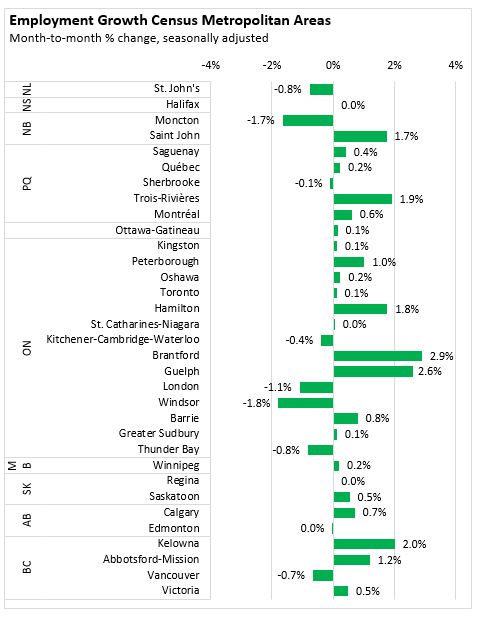
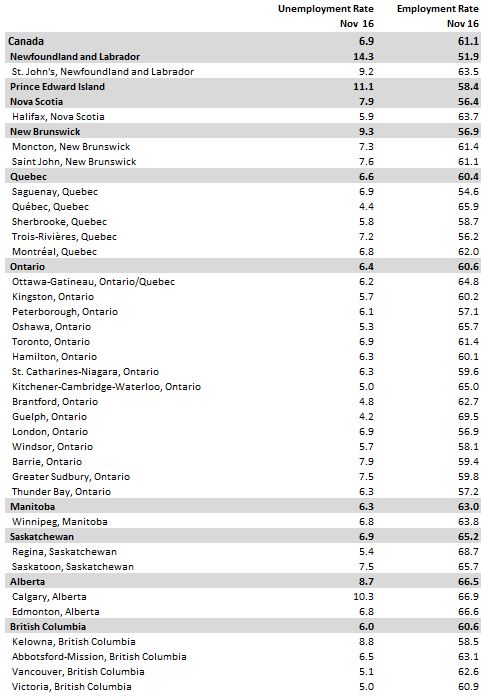
Note: Seasonally adjusted, 3 month average.